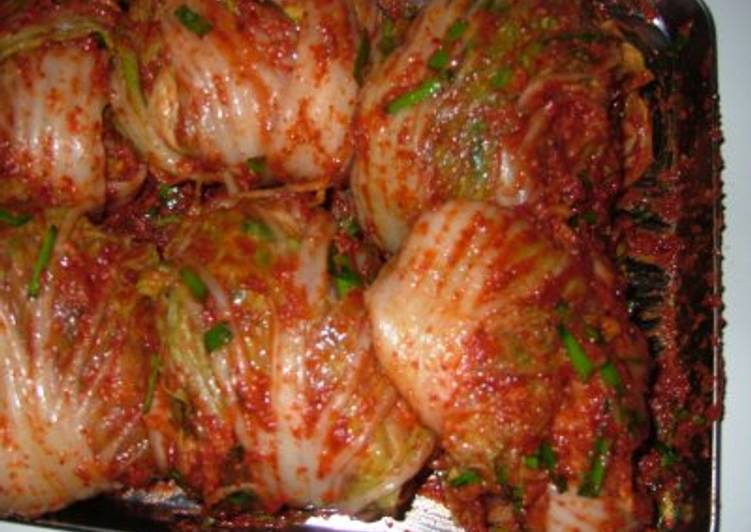Authentic Kimchi. If you love authentic Korean cuisine, you'll want to try your hand at creating your own kimchi; it's not as complicated or time-consuming as you might think. Kimchi is a fermented dish, the more it ages the better it tastes, likewise with the sugar. Use a persimmon in place of the apple, if you prefer.
 Originated from pickled vegetables, there are now hundreds of kimchi varieties in Korea. This authentic Korean Kimchi recipe is a simplified version of my grandmother's complicated recipe. It's called "Mak Kimchi," an 'easy' and 'care-free' version that you can make any time of the year with just a few ingredients. You can cook Authentic Kimchi using 19 ingredients and 13 steps. Here is how you cook that.
Originated from pickled vegetables, there are now hundreds of kimchi varieties in Korea. This authentic Korean Kimchi recipe is a simplified version of my grandmother's complicated recipe. It's called "Mak Kimchi," an 'easy' and 'care-free' version that you can make any time of the year with just a few ingredients. You can cook Authentic Kimchi using 19 ingredients and 13 steps. Here is how you cook that.
Ingredients of Authentic Kimchi
- You need of Chinese cabbage.
- Prepare of Salt for pickling (5% of the weight of the cabbages).
- Prepare of Daikon radish.
- You need of The white part of a Japanese leek.
- It's of Green onions.
- Prepare of Chinese chives.
- Prepare of Onion.
- You need of Asian pear or apple.
- It's of Garlic.
- Prepare of Ginger.
- It's of piece Kombu.
- Prepare of Scallops.
- It's of to 6 Ama-ebi shrimp (with their shells on).
- You need of Salt-preserved squid (ika no shiokara).
- It's of The liquid from salt-preserved sardines.
- You need of Sugar.
- It's of Dried red chili peppers (coarsely ground).
- You need of Dried red chili peppers (finely shredded).
- It's of Rice porridge (okayu).
When it comes to Korean cuisine, perhaps no dish is better known worldwide than kimchi. This funky, flavorful staple of the Korean table is a traditional dish of fermented salted vegetables that has been prepared in the Korean peninsula for centuries. Kimchi is a Korean staple of pickled vegetables, and is most often used as a side dish at mealtime. Although the most well-known type is made out of napa cabbage, there are actually many different varieties of kimchi to enjoy —and not all of them are spicy.
Authentic Kimchi step by step
- Cut the Chinese cabbage heads into quarters, and salt with 5% of their weight in salt the day before you plan to make the kimchi. (Make sure to put plenty of salt on the tougher root ends.) The next day, when moisture has come out of the cabbage and it is immersed in it, drain off the moisture in a colander..
- Make the additional ingredients. Cut the daikon radish into 4 cm long julienne, sprinkle with salt and leave until wilted. Squeeze out the moisture..
- Cut the green onion and Chinese chives into 3 cm long pieces. Cut the leek into 3 cm long pieces and julienne..
- Put the onion, pear, garlic and ginger into a food processor and process until chopped and combined..
- Soak the konbu seaweed in water until softened, and shred finely. Combine with the scallops, ama-ebi shrimp, and the salt-preserved sardine liquid in a food processor. Process until the shrimp shells are completely chopped..
- From this point on protect your hands with gloves. Sprinkle half the chili pepper onto the daikon radish from Step 2, and mix well until it has all turned red..
- Process the salt-preserved squid in a food processor until it's chopped up. Add this to the Step 6 mixture with the sugar, and squeeze and mix together with your hands..
- Add the Step 5 konbu seaweed and the Step 5 scallop-shrimp mixture and mix and rub it all together with your hands..
- Add the chopped up garlic mixture from Step for and mix it in. Add the rest of the chili peppers and rice porridge, and mix well..
- Add the chopped up green onion, leek and Chinese chives. Mix to combine. The seasoning ingredient mix is finished..
- Next, combine the seasoning mix with the Chinese cabbage. If the cabbage is still wet dry it well with paper towels. Push in the seasoning mix between the leaves of the cabbage..
- Roll up the cabbage pieces, wrap each one with the outermost leaves, and it's done..
- Kimchi is a fermented food, so don't eat it right after you make it. It's best after resting in the refrigerator for at least 4 days. Once it tastes right, store it in the partial freezing compartment (almost freezing) of your refrigerator to slow down further fermentation..
As with most food staples, kimchi is important to Korean culture as a whole. Traditional Kimchi Kimchi is both a ubiquitous Korean side dish and the star ingredient in a host of classic recipes. Kimchi Recipe - Authentic Korean Kimchi Recipe. Are you looking for the authentic Korean kimchi recipe? This kimchi recipe is your answer.
Comments
Post a Comment